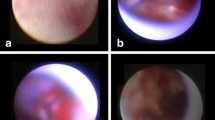Abstract
Very late stent thrombosis (>1 year: VLST) is a major concern in the drug-eluting stent (DES) era. VLST occurs not only in patients implanted with DESs but also in those implanted with bare-metal stents (BMSs). We examined intravascular ultrasound (IVUS) findings in patients with VLST after BMS implantation. Five consecutive patients presented with VLST as ST elevation myocardial infarction. VLST occurred at a mean of 9.5 years after BMS implantation. In the IVUS findings, the minimum stent area was 7.8 ± 1.2 mm2. None of the patients had incomplete stent apposition or stent underexpansion, which was defined as a stent expansion index of <0.8. The mean stent expansion index was 1.01. Calcium deposits in the previous stented segment were observed in 4 patients (80%), and a total of 14 calcium deposits were observed in all patients. The calcification pattern was superficial (78.5%) and spotty (57.1%) within a calcium arc of <90°. The mean calcium arc was 72.5° ± 88.5°. A ruptured plaque with an intraluminal flap was detected in all cases. According to the IVUS findings of ruptured plaque and calcium deposits, VLST after BMS might be caused by a thrombus formation subsequent to a calcified atherosclerotic plaque rupture.



Similar content being viewed by others
References
Windecker S, Meier B. Late coronary stent thrombosis. Circulation. 2007;116:1952–65.
Joner M, Finn AV, Farb A, Mont EK, Kolodgie FD, Ladich E, et al. Pathology of drug-eluting stents in humans: delayed healing and late thrombotic risk. J Am Coll Cardiol. 2006;48:193–202.
Cook S, Wenaweser P, Togni M, Billinger M, Morger C, Seiler C, et al. Incomplete stent apposition and very late stent thrombosis after drug-eluting stent implantation. Circulation. 2007;115:2426–34.
Virmani R, Guagliumi G, Farb A, Musumeci G, Grieco N, Motta T, et al. Localized hypersensitivity and late coronary thrombosis secondary to a sirolimus-eluting stent: should we be cautious? Circulation. 2004;109:701–5.
Takano M, Mizuno K. Coronary angioscopic evaluation for serial changes of luminal appearance after pharmacological and catheter interventions. Circ J. 2010;74:240–5.
Takano M, Yamamoto M, Mizuno K. Two cases of coronary stent thrombosis very late after bare-metal stenting. JACC Cardiovasc Interv. 2009;2:1286–7.
Lee CW, Kang SJ, Park DW, Lee SH, Kim YH, Kim JJ, et al. Intravascular ultrasound findings in patients with very late stent thrombosis after either drug-eluting or bare-metal stent implantation. J Am Coll Cardiol. 2010;55:1936–42.
Doyle B, Rihal CS, O’Sullivan CJ, Lennon RJ, Wiste HJ, Bell M, et al. Outcomes of stent thrombosis and restenosis during extended follow-up of patients treated with bare-metal coronary stents. Circulation. 2007;116:2391–8.
Cutlip DE, Windecker S, Mehran R, Boam A, Cohen DJ, van Es GA, et al. Clinical end points in coronary stent trials: a case for standardized definitions. Circulation. 2007;115:2344–51.
Mintz GS, Nissen SE, Anderson WD, Bailey SR, Erbel R, Fitzgerald PJ, et al. American College of Cardiology Clinical Expert Consensus Document on Standards for Acquisition, Measurement and Reporting of Intravascular Ultrasound Studies (IVUS). A report of the American College of Cardiology Task Force on Clinical Expert Consensus Documents. J Am Coll Cardiol. 2001;37:1478–92.
Ehara S, Kobayashi Y, Yoshiyama M, Shimada K, Shimada Y, Fukuda D, et al. Spotty calcification typifies the culprit plaque in patients with acute myocardial infarction: an intravascular ultrasound study. Circulation. 2004;110:3424–9.
Doi H, Maehara A, Mintz GS, Tsujita K, Kubo T, Castellanos C, et al. Classification and potential mechanisms of intravascular ultrasound patterns of stent fracture. Am J Cardiol. 2009;103:818–23.
Stone GW, Moses JW, Ellis SG, Schofer J, Dawkins KD, Morice MC, et al. Safety and efficacy of sirolimus- and paclitaxel-eluting coronary stents. N Engl J Med. 2007;356:998–1008.
Hassan AK, Bergheanu SC, Stijnen T, van der Hoeven BL, Snoep JD, Plevier JW, et al. Late stent malapposition risk is higher after drug-eluting stent compared with bare-metal stent implantation and associates with late stent thrombosis. Eur Heart J. 2010;31:1172–80.
Hong MK, Mintz GS, Lee CW, Kim YH, Lee SW, Song JM, et al. Incidence, mechanism, predictors, and long-term prognosis of late stent malapposition after bare-metal stent implantation. Circulation. 2004;109:881–6.
Hong MK, Mintz GS, Lee CW, Park DW, Park KM, Lee BK, et al. Late stent malapposition after drug-eluting stent implantation: an intravascular ultrasound analysis with long-term follow-up. Circulation. 2006;113:414–9.
Kotani J, Awata M, Nanto S, Uematsu M, Oshima F, Minamiguchi H, et al. Incomplete neointimal coverage of sirolimus-eluting stents: angioscopic findings. J Am Coll Cardiol. 2006;47:2108–11.
Kimura T, Abe K, Shizuta S, Odashiro K, Yoshida Y, Sakai K, et al. Long-term clinical and angiographic follow-up after coronary stent placement in native coronary arteries. Circulation. 2002;105:2986–91.
Hasegawa K, Tamai H, Kyo E, Kosuga K, Ikeguchi S, Hata T, et al. Histopathological findings of new in-stent lesions developed beyond five years. Catheter Cardiovasc Interv. 2006;68:554–8.
Inoue K, Abe K, Ando K, Shirai S, Nishiyama K, Nakanishi M, et al. Pathological analyses of long-term intracoronary Palmaz–Schatz stenting; Is its efficacy permanent? Cardiovasc Pathol. 2004;13:109–15.
Yokoyama S, Takano M, Yamamoto M, Inami S, Sakai S, Okamatsu K, et al. Extended follow-up by serial angioscopic observation for bare-metal stents in native coronary arteries: from healing response to atherosclerotic transformation of neointima. Circ Cardiovasc Interv. 2009;2:205–12.
Takano M, Yamamoto M, Inami S, Murakami D, Ohba T, Seino Y, et al. Appearance of lipid-laden intima and neovascularization after implantation of bare-metal stents extended late-phase observation by intracoronary optical coherence tomography. J Am Coll Cardiol. 2009;55:26–32.
Ehara S, Kobayashi Y, Yoshiyama M, Ueda M, Yoshikawa J. Coronary artery calcification revisited. J Atheroscler Thromb. 2006;13:31–7.
Richardson PD, Davies MJ, Born GV. Influence of plaque configuration and stress distribution on fissuring of coronary atherosclerotic plaques. Lancet. 1989;2:941–4.
Author information
Authors and Affiliations
Corresponding author
Rights and permissions
About this article
Cite this article
Yumoto, K., Anzai, T., Aoki, H. et al. Calcified plaque rupture and very late stent thrombosis after bare-metal stent implantation. Cardiovasc Interv and Ther 26, 252–259 (2011). https://doi.org/10.1007/s12928-011-0070-3
Received:
Accepted:
Published:
Issue Date:
DOI: https://doi.org/10.1007/s12928-011-0070-3




